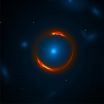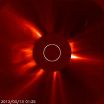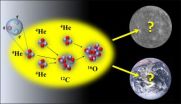(Press-News.org) PASADENA, Calif.—Galaxies have been experiencing vigorous bursts of star formation from much earlier in cosmic history than previously thought, according to new observations by a Caltech-led team.
These so-called starburst galaxies produce stars at a prodigious rate—creating the equivalent of a thousand new suns per year. Now the astronomers have found starbursts that were churning out stars when the universe was just a billion years old. Previously, astronomers didn't know whether galaxies could form stars at such high rates so early in time.
The discovery enables astronomers to study the earliest bursts of star formation and to deepen their understanding of how galaxies formed and evolved. The team describes their findings in a paper being published online on March 13 in the journal Nature and in two others that have been accepted for publication in the Astrophysical Journal.
Shining with the energy of over a hundred trillion suns, these newly discovered galaxies represent what the most massive galaxies in our cosmic neighborhood looked like in their star-making youth. "I find that pretty amazing," says Joaquin Vieira, a postdoctoral scholar at Caltech and leader of the study. "These aren't normal galaxies. They were forming stars at an extraordinary rate when the universe was very young—we were very surprised to find galaxies like this so early in the history of the universe."
The astronomers found dozens of these galaxies with the South Pole Telescope (SPT), a 10-meter dish in Antarctica that surveys the sky in millimeter-wavelength light—which is between radio waves and infrared on the electromagnetic spectrum. The team then took a more detailed look using the new Atacama Large Millimeter Array (ALMA) in Chile's Atacama Desert.
The new observations represent some of ALMA's most significant scientific results yet, Vieira says. "We couldn't have done this without the combination of SPT and ALMA," he adds. "ALMA is so sensitive, it is going to change our view of the universe in many different ways.
The astronomers only used the first 16 of the 66 dishes that will eventually form ALMA, which is already the most powerful telescope ever constructed for observing at millimeter and submillimeter wavelengths.
With ALMA, the astronomers found that more than 30 percent of the starburst galaxies are from a time period just 1.5 billion years after the big bang. Previously, only nine such galaxies were known to exist, and it wasn't clear whether galaxies could produce stars at such high rates so early in cosmic history. Now, with the new discoveries, the number of such galaxies has nearly doubled, providing valuable data that will help other researchers constrain and refine theoretical models of star and galaxy formation in the early universe.
But what's particularly special about the new findings, Vieira says, is that the team determined the cosmic distance to these dusty starburst galaxies by directly analyzing the star-forming dust itself. Previously, astronomers had to rely on a cumbersome combination of indirect optical and radio observations using multiple telescopes to study the galaxies. But because of ALMA's unprecedented sensitivity, Vieira and his colleagues were able make their distance measurements in one step, he says. The newly measured distances are therefore more reliable and provide the cleanest sample yet of these distant galaxies.
The measurements were also made possible because of the unique properties of these objects, the astronomers say. For one, the observed galaxies were selected because they could be gravitationally lensed—a phenomenon predicted by Einstein in which another galaxy in the foreground bends the light from the background galaxy like a magnifying glass. This lensing effect makes background galaxies appear brighter, cutting the amount of telescope time needed to observe them by 100 times.
Secondly, the astronomers took advantage of a fortuitous feature in these galaxies' spectra—which is the rainbow of light they emit—dubbed the "negative K correction." Normally, galaxies appear dimmer the farther away they are—in the same way a lightbulb appears fainter the farther away it is. But it turns out that the expanding universe shifts the spectra in such a way that light in millimeter wavelengths doesn't appear dimmer at greater distances. As a result, the galaxies appear just as bright in these wavelengths no matter how far away they are—like a magic lightbulb that appears just as bright no matter how distant it is.
"To me, these results are really exciting because they confirm the expectation that when ALMA is fully available, it can really allow astronomers to probe star formation all the way up to the edge of the observable universe," says Fred Lo, who, while not a participant in the study, was recently a Moore Distinguished Scholar at Caltech. Lo is a Distinguished Astronomer and Director Emeritus at the National Radio Astronomy Observatory, the North American partner of ALMA.
Additionally, observing the gravitational lensing effect will help astronomers map the dark matter—the mysterious unseen mass that makes up nearly a quarter of the universe—in the foreground galaxies. "Making high-resolution maps of the dark matter is one of the future directions of this work that I think is particularly cool," Vieira says.
These results represent only about a quarter of the total number of sources discovered by Vieira and his colleagues with the SPT, and they anticipate finding additional distant, dusty, starburst galaxies as they continue analyzing their data set. The ultimate goal for astronomers, Lo says, is to observe galaxies at all wavelengths throughout the history of the universe, piecing together the complete story of how galaxies have formed and evolved. So far, astronomers have made much progress in creating computer models and simulations of early galaxy formation, he says. But only with data—such as these new galaxies—will we ever truly piece together cosmic history. "Simulations are simulations," he says. "What really counts is what you see."
INFORMATION:
In addition to Vieira, the other Caltech authors on the Nature paper are Jamie Bock, professor of physics; Matt Bradford, visiting associate in physics; Martin Lueker-Boden, postdoctoral scholar in physics; Stephen Padin, senior research associate in astrophysics; Erik Shirokoff, a postdoctoral scholar in astrophysics with the Keck Institute for Space Studies; and Zachary Staniszewski, a visitor in physics. There are a total of 70 authors on the paper, which is titled "High-redshift, dusty, starburst galaxies revealed by gravitational lensing." This research was funded by the National Science Foundation, the Kavli Foundation, the Gordon and Betty Moore Foundation, NASA, the Natural Sciences and Engineering Research Council of Canada, the Canadian Research Chairs program, and the Canadian Institute for Advanced Research.
The work to measure the distances to the galaxies is described in the Astrophysical Journal paper "ALMA redshifts of millimeter-selected galaxies from the SPT survey: The redshift distribution of dusty star-forming galaxies," by Axel Weiss of the Max-Planck-Institut für Radioastronomie, and others. The study of the gravitational lensing is described in the Astrophysical Journal paper "ALMA observations of strongly lensed dusty star-forming galaxies," by Yashar Hezaveh of McGill University, and others.
ALMA, an international astronomy facility, is a partnership of Europe, North America, and East Asia in cooperation with the Republic of Chile. ALMA construction and operations are led on behalf of Europe by the European Southern Observatory (ESO) organization, on behalf of North America by the National Radio Astronomy Observatory (NRAO), and on behalf of East Asia by the National Astronomical Observatory of Japan (NAOJ). The Joint ALMA Observatory (JAO) provides the unified leadership and management of the construction, commissioning, and operation of ALMA.
The South Pole Telescope (SPT) is a 10-meter telescope located at the National Science Foundation (NSF) Amundsen-Scott South Pole Station, which lies within one kilometer of the geographic south pole. The SPT is designed to conduct low-noise, high-resolution surveys of the sky at millimeter and submillimeter wavelengths, with the particular design goal of making ultrasensitive measurements of the cosmic microwave background (CMB). The first major survey with the SPT was completed in October 2011 and covers 2,500 square degrees of the southern sky in three millimeter-wave observing bands. This is the deepest large millimeter-wave data set in existence and has already led to many groundbreaking science results, including the first detection of galaxy clusters through their Sunyaev-Zel'dovich effect signature, the most sensitive measurement yet of the small-scale CMB power spectrum, and the discovery of a population of ultrabright, high-redshift, star-forming galaxies. The SPT is funded primarily by the Division of Polar Programs in NSF's Geoscience Directorate. Partial support also is provided by the Kavli Institute for Cosmological Physics (KICP), an NSF-funded Physics Frontier Center; the Kavli Foundation; and the Gordon and Betty Moore Foundation. The SPT collaboration is led by the University of Chicago and includes research groups at Argonne National Laboratory, the California Institute of Technology, Cardiff University, Case Western Reserve University, Harvard University, Ludwig-Maximilians-Universität, the Smithsonian Astrophysical Observatory, McGill University, the University of Arizona, the University of California at Berkeley, the University of California at Davis, the University of Colorado at Boulder, and the University of Michigan, as well as individual scientists at several other institutions, including the European Southern Observatory and the Max-Planck-Institut für Radioastronomie in Bonn, Germany.
Written by Marcus Woo
Bursts of star formation in the early universe
2013-03-14
ELSE PRESS RELEASES FROM THIS DATE:
1 in 4 colonoscopies in Medicare patients found to be potentially inappropriate
2013-03-14
Colonoscopy is one of the most effective cancer screening procedures available. Colon cancer grows very slowly and can be treated if caught early through screening. But, perhaps because of this success, older Americans are undergoing screening colonoscopies despite recommendations against screening in adults aged 76 and older.
A new study by researchers at the University of Texas Medical Branch at Galveston published online today in JAMA Internal Medicine shows that one out of four colonoscopies paid for by Medicare is potentially inappropriate under current screening ...
More accurate, sensitive DNA test allows early identification of fungus causing WNS
2013-03-14
MADISON, Wis., March 13, 2013 – Even after researchers studying White Nose Syndrome (WNS) established that a fungus called Geomyces destructans is at the heart of the devastating disease, detecting it depended largely on finding dead or dying bats.
This month, the journal Mycologia will publish research by a team of U.S. Forest Service scientists and partners identifying additional species of Geomyces and describing development of a highly sensitive DNA-based technique for early identification of Geomyces destructans on bats as well as in soils and on cave walls.
"The ...
Symbols, such as traffic lights, on menus effective in educating diners
2013-03-14
CHAMPAIGN, Ill. — A little-noticed provision of the Affordable Care Act requires all chain restaurants and retail food establishments with 20 or more locations to list calorie counts on their menus. But according to research co-written by a University of Illinois agricultural economist, numeric calorie labels might not be the most effective way to influence patrons to select "healthier" (often interpreted as lower-calorie) items.
Brenna Ellison, a professor of agricultural and consumer economics, says placing a symbolic label in addition to the numeric calorie information ...
NASA sees large decrease in Cyclone Sandra's rainfall intensity
2013-03-14
NASA's Tropical Rainfall Measuring Mission satellite, also known as TRMM, flew over Cyclone Sandra twice in one day and noticed a large decrease in rainfall intensity over a nine hour period.
On March 11, 2013, NASA's TRMM satellite twice flew above weakening tropical cyclone Sandra as it was passing to the west of New Caledonia in the southern Pacific Ocean. TRMM's Precipitation Radar (PR) had a very good view of Sandra as it passed directly above the tropical cyclone on March 11 at 1312 UTC (9:12 a.m. EST). TRMM PR measured rainfall at the extreme rate of over 206 mm ...
Dwelling on stressful events can increase inflammation in the body, study finds
2013-03-14
ATHENS, Ohio (March 13, 2013)—Dwelling on negative events can increase levels of inflammation in the body, a new Ohio University study finds.
Researchers discovered that when study participants were asked to ruminate on a stressful incident, their levels of C-reactive protein, a marker of tissue inflammation, rose. The study is the first time to directly measure this effect in the body.
"Much of the past work has looked at this in non-experimental designs. Researchers have asked people to report their tendency to ruminate, and then looked to see if it connected to physiological ...
Scientists discover novel chemical that controls cell behavior
2013-03-14
March 12, 2013 — Albuquerque, NM (UNM Cancer Center) — It's the spread of the original cancer tumor that kills most people. That's why cancer researchers vigorously search for drugs that can prevent metastases, the spread of cancer. The research team co-led by Angela Wandinger-Ness, PhD, and Larry Sklar, PhD, at the University of New Mexico Cancer Center has found a chemical compound that appears to control cell migration and adhesion, two important characteristics of metastatic cancer cells. The team recently published a paper describing how the first-in-class compound ...
Sun spits out 2 CMEs
2013-03-14
The sun recently erupted with two coronal mass ejections (CMEs). One began at 8:36 p.m. EDT on March 12, 2013 and is directed toward three NASA spacecraft, Spitzer, Kepler and Epoxi. There is, however, no particle radiation associated with this event, which is what would normally concern operators of interplanetary spacecraft since the particles can trip computer electronics on board. A second CME began at 6:54 a.m. EDT on March 13, 2013 and its flank may pass by Earth at a speed that does not typically have a significant impact at Earth.
Experimental NASA research models, ...
Vitamin D may lower blood pressure in African-Americans
2013-03-14
Boston – High blood pressure, a risk factor for heart attacks, heart failure and stroke, is 40 percent more common in African-Americans than in other American ethnic groups. In a new study from Brigham and Women's Hospital (BWH), along with the Dana-Farber Cancer Institute and Massachusetts General Hospital, researchers show that vitamin D supplementation may help African-Americans lower their blood pressure. The study publishes online in the March 13, 2013 edition of the American Heart Association journal Hypertension.
"This study may explain and help treat an important ...
US lifespans lags other high-income countries, tied to mortality rates under age 50
2013-03-14
Higher mortality rates among Americans younger than 50 are responsible for much of why life expectancy is lower in the United States than most of the world's most developed nations.
The research, by Jessica Ho, a University of Pennsylvania doctoral candidate in demography and sociology, found that excess mortality among Americans younger than 50 accounted for two-thirds of the gap in life expectancy at birth between American males and their counterparts and two-fifths between females and their counterparts in the comparison countries.
The study, "Mortality Under Age ...
Foundations of carbon-based life leave little room for error
2013-03-14
Life as we know it is based upon the elements of carbon and oxygen. Now a team of physicists, including one from North Carolina State University, is looking at the conditions necessary to the formation of those two elements in the universe. They've found that when it comes to supporting life, the universe leaves very little margin for error.
Both carbon and oxygen are produced when helium burns inside of giant red stars. Carbon-12, an essential element we're all made of, can only form when three alpha particles, or helium-4 nuclei, combine in a very specific way. The ...




